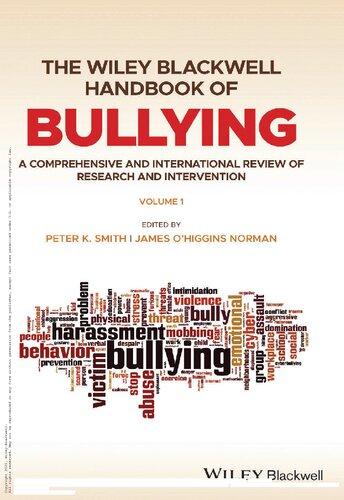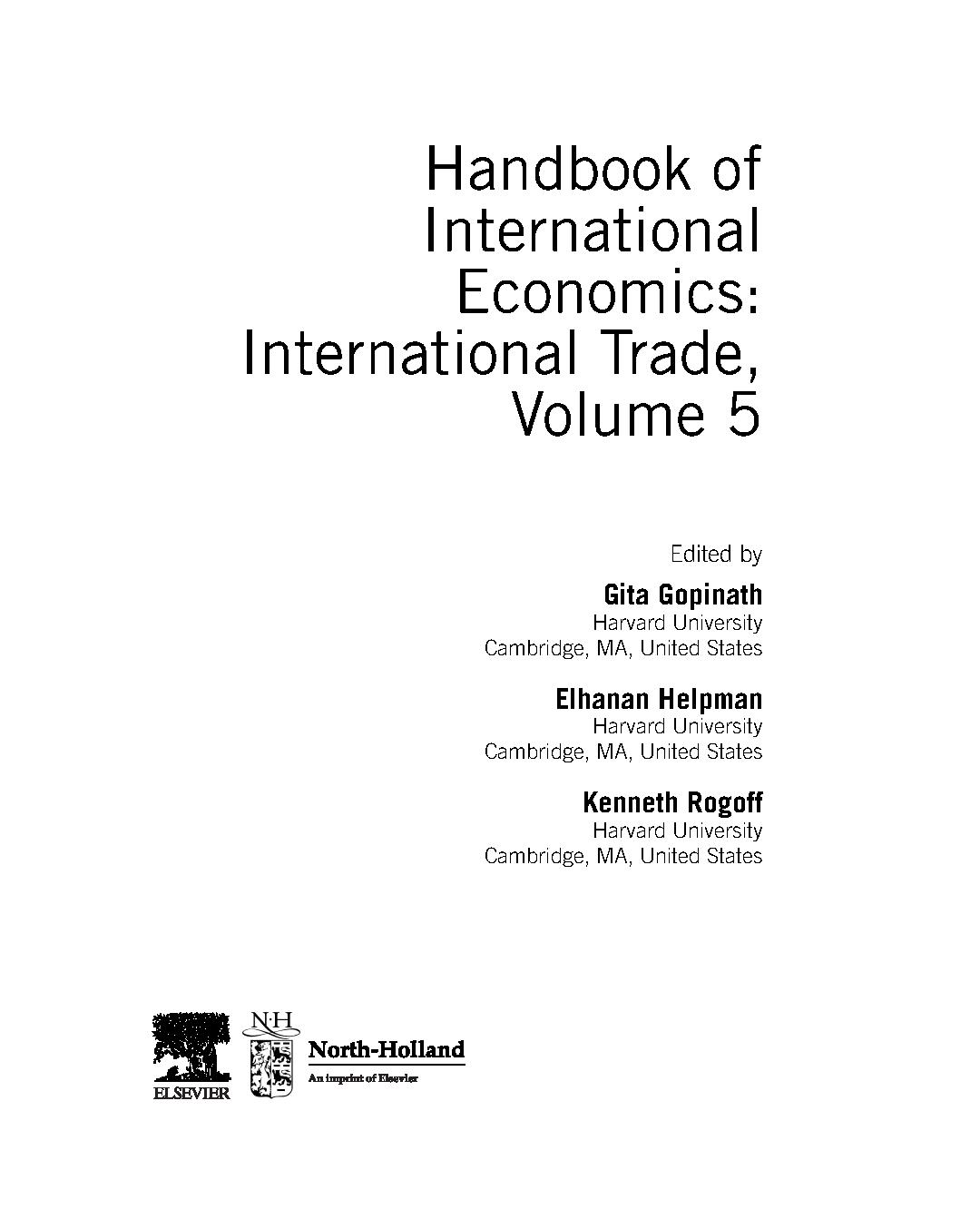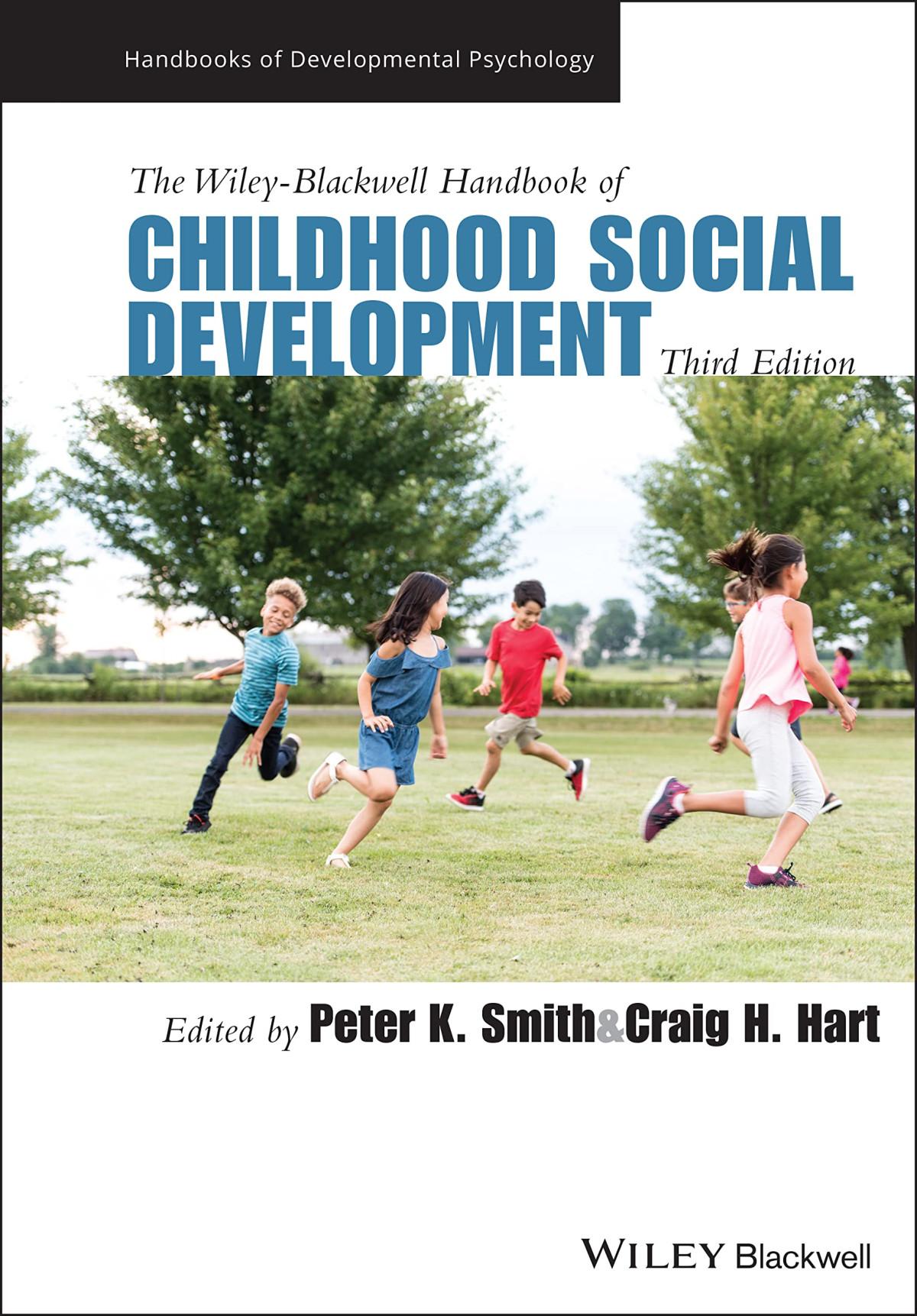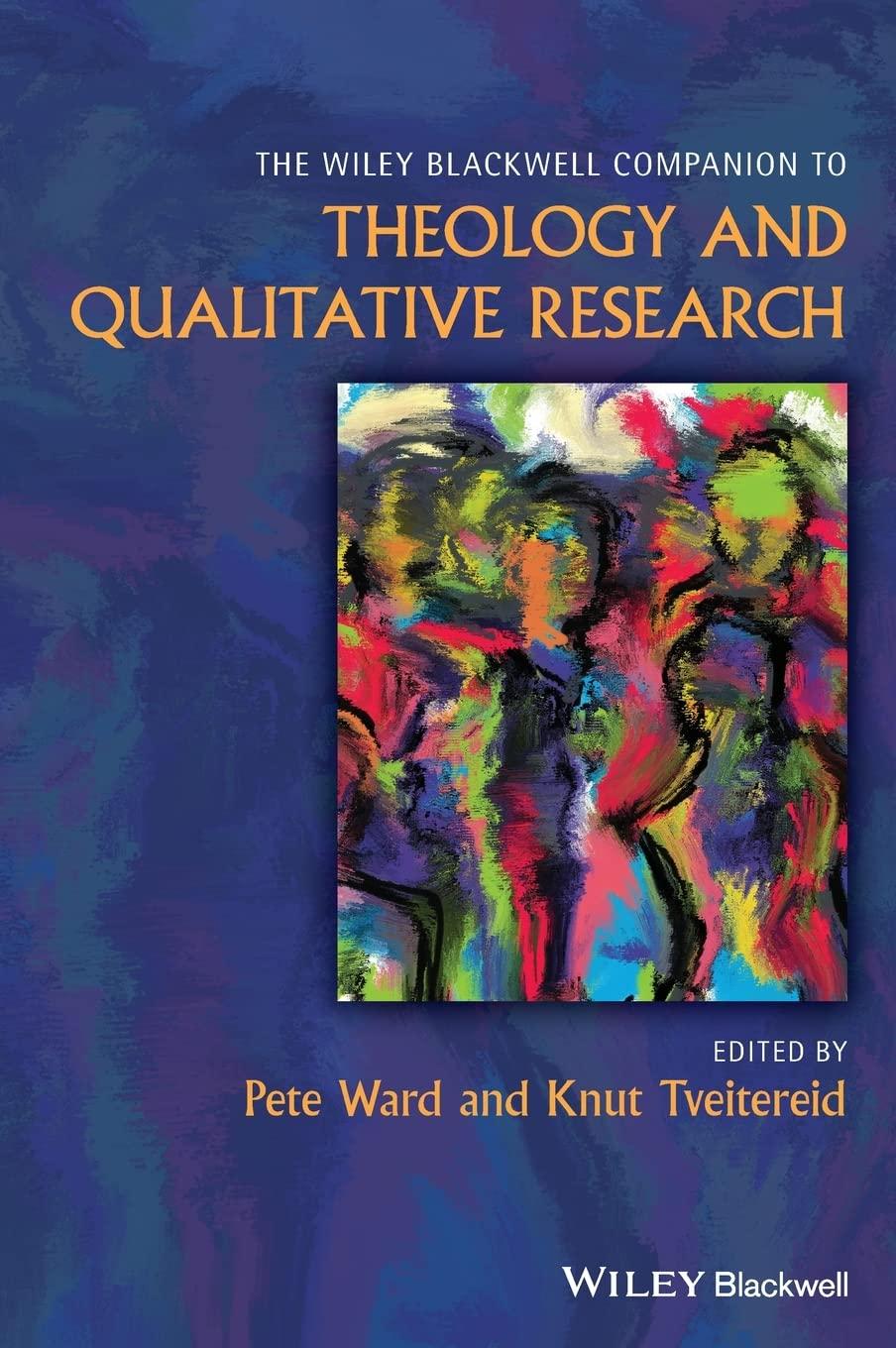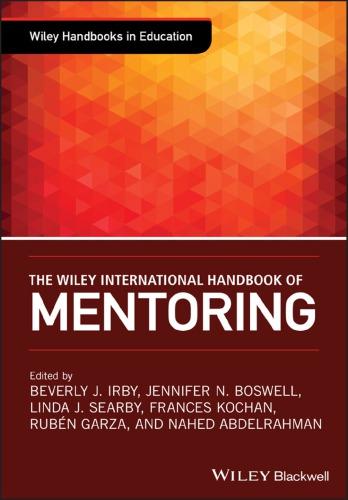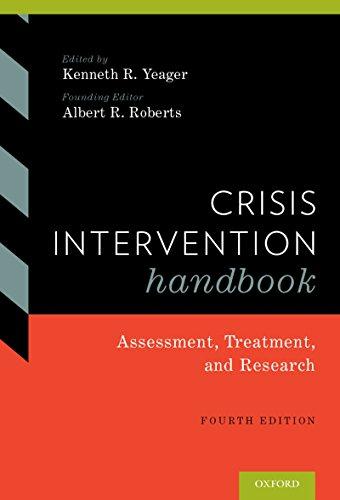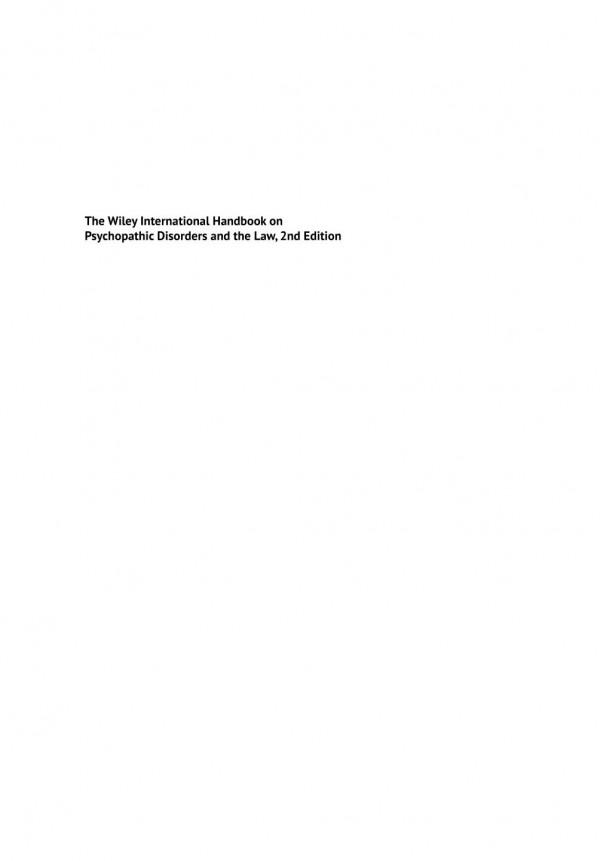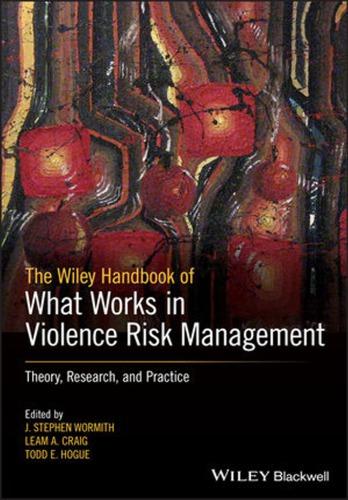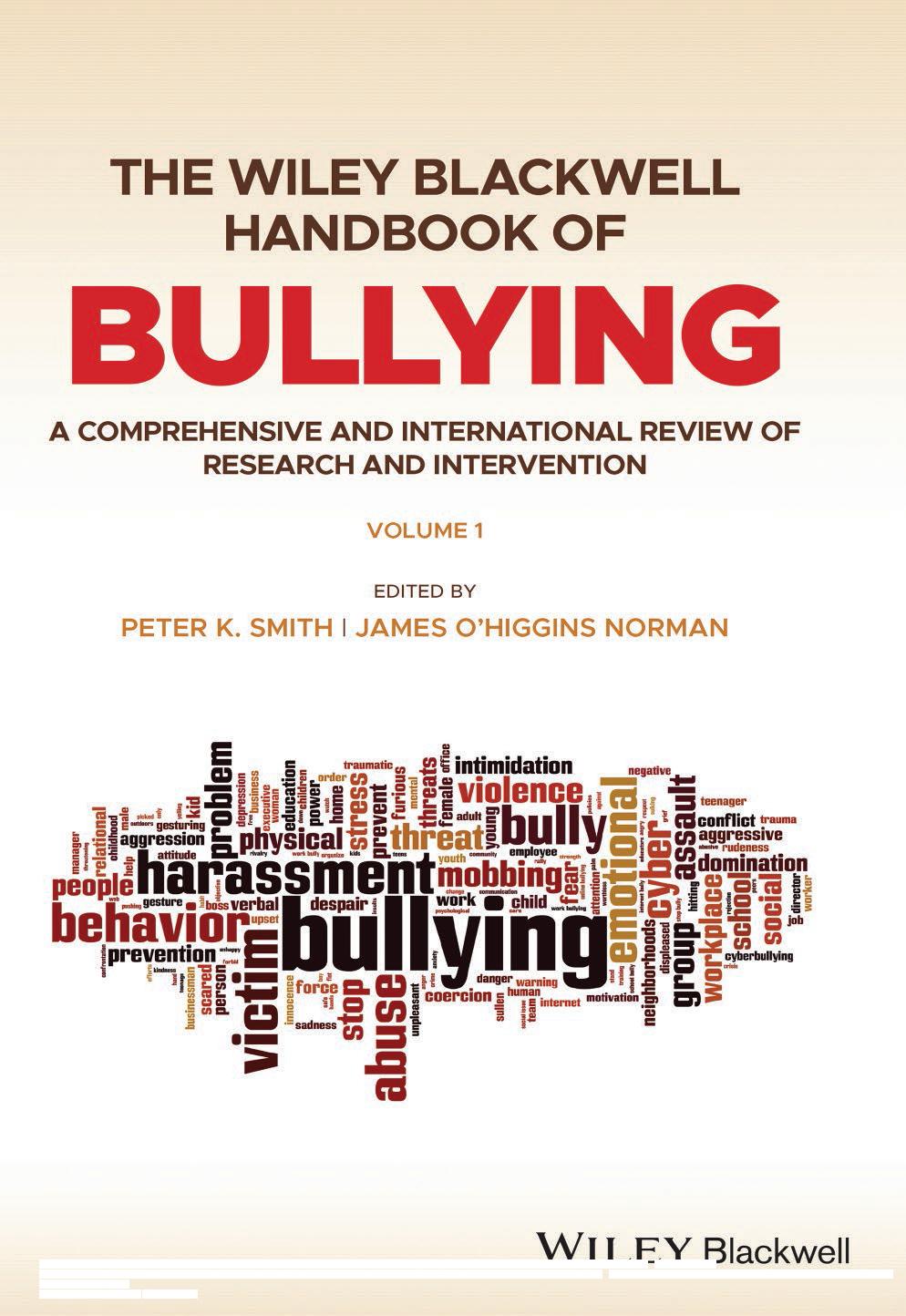The Wiley Blackwell Handbook of Bullying: A
Edited by Peter K. Smith and James O’Higgins Norman
This edition first published 2021 © 2021 John Wiley & Sons Ltd.
All rights reserved. No part of this publication may be reproduced, stored in a retrieval system, or transmitted, in any form or by any means, electronic, mechanical, photocopying, recording, or otherwise, except as permitted by law. Advice on how to obtain permission to reuse material from this title is available at http://www.wiley.com/go/permissions.
The right of Peter K. Smith and James O’Higgins Norman to be identified as the authors of the editorial material in this work has been asserted in accordance with law.
Registered Office(s)
John Wiley & Sons, Inc., 111 River Street, Hoboken, NJ 07030, USA
John Wiley & Sons Ltd, The Atrium, Southern Gate, Chichester, West Sussex, PO19 8SQ, UK
Editorial Office
The Atrium, Southern Gate, Chichester, West Sussex, PO19 8SQ, UK
For details of our global editorial offices, customer services, and more information about Wiley products visit us at www.wiley.com.
Wiley also publishes its books in a variety of electronic formats and by print-on-demand. Some content that appears in standard print versions of this book may not be available in other formats.
Limit of Liability/Disclaimer of Warranty
While the publisher and authors have used their best efforts in preparing this work, they make no representations or warranties with respect to the accuracy or completeness of the contents of this work and specifically disclaim all warranties, including without limitation any implied warranties of merchantability or fitness for a particular purpose. No warranty may be created or extended by sales representatives, written sales materials or promotional statements for this work. The fact that an organization, website, or product is referred to in this work as a citation and/or potential source of further information does not mean that the publisher and authors endorse the information or services the organization, website, or product may provide or recommendations it may make. This work is sold with the understanding that the publisher is not engaged in rendering professional services. The advice and strategies contained herein may not be suitable for your situation. You should consult with a specialist where appropriate. Further, readers should be aware that websites listed in this work may have changed or disappeared between when this work was written and when it is read. Neither the publisher nor authors shall be liable for any loss of profit or any other commercial damages, including but not limited to special, incidental, consequential, or other damages.
Library of Congress Cataloging-in-Publication Data
Names: Smith, Peter K., editor. | O’Higgins Norman, James, 1968- editor.
Title: The Wiley Blackwell handbook of bullying / edited by Peter K. Smith, James O’Higgins Norman.
Description: Hoboken, NJ : John Wiley & Sons, 2021. | Includes bibliographical references and index.
Identifiers: LCCN 2020037441 (print) | LCCN 2020037442 (ebook) | ISBN 9781118482728 (hardback) | ISBN 9781118482704 (pdf) | ISBN 9781118482711 (epub) | ISBN 9781118482650 (ebook)
Subjects: LCSH: Bullying.
Classification: LCC BF637.B85 W53 2021 (print) | LCC BF637.B85 (ebook) | DDC 302.34/3--dc23
LC record available at https://lccn.loc.gov/2020037441
LC ebook record available at https://lccn.loc.gov/2020037442
Cover image: © Boris25/Getty Images
Cover design by Wiley
Set in 10.5/12.5 Adobe Garamond Pro by Integra Software Services Pvt. Ltd, Pondicherry, India
10 9 8 7 6 5 4 3 2 1
8
Angela Mazzone, Lenka Kollerová, & James O’Higgins
Jua B. P. Sanders, Sarah Malamut, & Antonius H. N. Cillessen
Seffetullah Kuldas, Maeve Dupont, & Mairéad Foody
Mona O’Moore & Lian
Hildegunn Fandrem, Dagmar Strohmeier, Simona C. S. Caravita, & Elisabeth Stefanek
Maude Comtois-Cabana, & Isabelle Ouellet-Morin
Kari Einarsen & Ståle Valvatne Einarsen
32 Bullying and Externalizing Problems 580 Johannes Foss Sigurdson, Jannike Kaasbøll, & Anne Mari Sund
33 Understanding the Associations Between Bullying, Suicide, and Self-Harm 600 John F. Gunn III & Sara E. Goldstein
34 School Bullying and Peer Victimization: Its Role in Students’ Academic Achievement 619 Becky Kochenderfer-Ladd, Gary W. Ladd, & Stephanie A. Thibault
Preface
A decade ago, Shane Jimerson, Dorothy Espelage, and Susan Swearer edited the Handbook of Bullying in Schools: An International Perspective (Routledge, 2010). This put down a marker for, and a state-of-the-art review of, the very considerable volume of research and action on school bullying over the previous 40 years. In the decade following this, research and action have proceeded further, at a sometimes seemingly dizzying pace. This new Handbook aims to provide a marker for, and a state-of-the-art review of, the progress that has been made. In this period, great strides forward have been taken in the international breadth of research, the range of settings considered, the understanding of causes, influences, and outcomes of bullying, and the practical steps that can be taken to reduce it. In addition, cyberbullying has come to be a major aspect of bullying in contemporary societies.
In this two-volume Handbook we have broadened out the coverage in two main ways: country and context. Although the 2010 Handbook had some international coverage, the great majority of authors were from the USA. We have aimed for a wide coverage of different countries and all six continents. Altogether, 30 countries across the globe are represented in our contributors. Researches from Europe, North America, and Australasia have been well represented for decades. We also have contributions from relatively well-known traditions of work in Japan, South Korea, and mainland China/ Hong Kong. In addition, we have chapters surveying the rapidly increasing, but not always easily accessible, research in India, the Arabic countries, sub-Saharan Africa, and South America.
Bullying can occur in many contexts, as was laid out a decade ago by Claire Monks and Iain Coyne in Bullying in Different Contexts (Cambridge University Press, 2011). The most developed area of study remains that of school bullying, and this takes up a major share of the volumes; but there is also coverage of bullying in colleges, dating situations, sports settings, workplaces, prisons, families, and care homes.
We hope that this Handbook will be the premier reference work for researchers and professionals concerned with topics around bullying, harassment, abuse, and mental well-being, for the decade to come. It has been a pleasure to work with many colleagues from across the globe in what has been quite a mammoth editing task. We would like to thank our many contributors for their patience in undertaking revisions, some of them while coping with the exigencies of the COVID-19 pandemic in early 2020. We are grateful to colleagues at Wiley-Blackwell for helping to see these two volumes through to publication. Also, a special thanks to Beatrice Sciacca, working in both Granada and in Dublin, who has been an immense support for us in our editorial work and in preparing the Index. We are also grateful to the Department of Education & Skills, Dublin, for support under the National Action Plan on Bullying for editing and indexing work on these volumes.
This Handbook represents the work and achievements of very many colleagues, across the globe. However, some colleagues will be very sadly missed. Professor Anna Constanza Baldry (1970–2019), who died in March 2019, studied at Rome, Cambridge, and Amsterdam, and then worked in Italy, notably in Naples and Milan, on topics related to bullying and violence. She developed the Threat Assessment of Bullying Behaviors among Youngsters (TABBY), a bullying intervention program implemented in eight countries. For her contributions she was awarded the Order of Merit of the Italian Republic. Professor Yohji Morita (1941–2019) died on the last day of 2019, following complications after an accidental fall. Yohji was the pioneer of ijime research in Japan. He described ijime as a group phenomenon and from the early 1980s inspired Japanese researchers’ interests and contributions for tackling ijime at schools. He also reached out to overseas researchers, and was coordinator of the International Bullying Symposium held in Japan in 1996, and of the OECD’s International Network on School Bullying and Violence. We remember him too as a warm and friendly personality and an inspiring colleague whose influence continues through his colleagues and students.
As this book was preparing for publication, we learnt of the death of Professor Dan Olweus (1931–2020), in September 2020. Swedish by birth, Dan spent the majority of his career in Bergen, Norway. His book Aggression in the Schools: Bullies and Whipping Boys (1973; 1978 in English) was the first major writing on the topic of school bullying, and his subsequent book Bullying at School: What We Know and What We Can Do (1993) was widely translated and very influential. Dan conducted the first systematic intervention study against bullying in the world and is considered as the founding father of school bullying research, certainly in Western countries. He developed a systematic questionnaire to investigate the phenomenon, and an intervention program, the Olweus Bullying Prevention Program, used in Norway, the USA, and several other countries, which has had notable continued success for a span of nearly 40 years. This is described in Volume 2, Chapter 22, on which Dan took the lead, with several colleagues. His awards included Distinguished Contributions to Public Policy for Children from the Society for Research in Child Development in 2003; Distinguished Contributions to the International Advancement of Psychology in 2011, and Distinguished Contributions to Research in Public Policy in 2012, both from the American Psychological Association. We remember Dan as a steadfast proponent of the importance of anti-bullying inter ventions, and
someone who inspired much of the research program and efforts presented in this Handbook.
An encouraging development to end on is the establishment by UNESCO of an International Day Against Violence and Bullying at School, including Cyberbullying. This starts in November 2020 and will continue on an annual basis, providing a focal point each year for all our anti-bullying efforts.
Peter K. Smith and James O’Higgins Norman London & Dublin, September 2020
List of Contributors
Volume 1
Daniela Acquadro Maran, University of Turin, Italy
Zoe Apostolidou, independent researcher, Cyprus
Sheri Bauman, University of Arizona, USA
Tatiana Begotti, University of Turin, Italy
Ioanna Bibou-Nakou, Aristotle University of Thessaloniki, Greece
Catherine Blaya, High School of Education of the Canton of Vaud, France
Lucy Bowes, Magdalen College Oxford, England
James M. E. Boyle, University of Strathclyde, Scotland
Mara Brendgen, University of Quebec at Montreal, Canada
Simona C. S. Caravita, University of Stavanger, Norway
Deborah M. Casper, University of Alabama, USA
W. Y. Alice Chan, McGill University, Canada
Theologos Chatzipemou, University of West Attica, Greece
Antonius H. N. Cillessen, Radboud University, the Netherlands
Maude Comtois-Cabana, University of Montreal, Canada
Michelle Demaray, Northern Illinois University, USA
Maeve Dupont, Dublin City University, Ireland
Kari Einarsen, University of Bergen, Norway
Ståle Valvatne Einarsen, University of Bergen, Norway
Dorothy Espelage, University of North Carolina at Chapel Hill, USA
Hildegunn Fandrem, University of Stavanger, Norway
Kostas A. Fanti, University of Cyprus, Cyrpus
Mairéad Foody, Dublin City University, Ireland
Hannah Fritz, University of Southern California, USA
Emma Galarneau, University of Toronto, Canada
Claire F. Garandeau, University of Turku, Finland
Gianluca Gini, University of Padua. Italy
Sara E. Goldstein, Montclaire State University, USA
Anke Görzig, Greenwich University, England
John F. Gunn III, Rutgers School of Criminal Justice, USA
Carolina Guzman Holst, University of Oxford, England
Lisa Hellstrom, Malmö University, Sweden
Markus Hess, German University of Health and Sports, Germany
Paul Horton, Linköping University, Sweden
Gijs Huitsing, University of Groningen, the Netherlands
Simon C. Hunter, Glasgow Caledonian University, Scotland
Lyndsay Jenkins, Florida State University, USA
Jannike Kaasbøll, Norwegian University of Science and Technology, Norway
Stavroula Karga, Aristotle University of Thessaloniki, Greece
Annemarie Kelleghan, University of Southern California, USA
Becky Kochenderfer-Ladd, Arizona State University, USA
Lenka Kollerová, Czech Academy of Sciences, Czech Republic
Seffetullah Kuldas, Dublin City University, Ireland
Gary W. Ladd, Arizona State University, USA
Sarah Malamut, University of Southern California, USA
Tina Malti, University of Toronto, Canada
Angela Mazzone, Dublin City University, Ireland
Lian McGuire, Dublin City Universit, Ireland.
Nathalie Noret, York St. John University, England
Niamh O’Brien, Anglia Ruskin University, England
James O’Higgins Norman, Dublin City University, Ireland
Mona O’Moore, Dublin City University, Ireland
Isabelle Ouellet-Morin, University of Montreal, Canada
Iryna S. Palamarchuk, University of Ottawa, Canada
Debra Pepler, York University, Canada
Jan Pfetsch, Technical University of Berlin, Germany
Kathryn Pierce, York University, Canada
J. Loes Pouwels, University of Amsterdam, the Netherlands
Tiziana Pozzoli, University of Padua, Italy
Ian Rivers, University of Strathclyde, Scotland
Susanne Robinson, Goldsmiths College, University of London, England
Yana Ryjova, University of Southern California, USA
Jua B. P. Sanders, Radboud University, the Netherlands
Herbert Scheithauer, Free University of Berlin, Germany
Anja Schultze-Krumbholz, Technical University of Berlin, Germany
David Schwartz, University of Southern California, USA
Johannes Foss Sigurdson, Norwegian University of Science and Technology, Norway
Robert Slonje, Goldsmiths College, University of London, England
Peter K. Smith, Goldsmiths College, University of London, England
Catherine Stapleton, Dublin City University, Ireland
Elisabeth Stefanek, Pro Mente Forschung, Austria
Dagmar Strohmeier, University of Applied Sciences Upper Austria, Austria
Anne Mari Sund, Norwegian University of Science and Technology, Norway
Madison Sween, University of Arizona, USA
Stephanie A. Thibault, Arizona State University, USA
Robert Thornberg, Linköping University, Sweden
Tracy Vaillancourt, University of Ottawa, Canada
René Veenstra, University of Groningen, the Netherlands
Sebastian Wachs, University of Potsdam, Germany
Michelle Wright, Pennsylvania State University, USA
Georgia Zacharaki, University of Cyprus, Cyprus
Definitions of Bullying
Lisa Hellström, Robert Thornberg, & Dorothy L. Espelage
According to Harper’s (2001–2019a) online etymology dictionary, the word bully (as a noun) can be traced back to the 1530s, but the definition differed remarkably from definitions that pervade the academic literature during the last five decades. In the 1500s, bully was defined as “sweetheart,” which might derive from the Dutch word boel, meaning “lover” and “brother.” Furthermore, according to Crawford (1999), bully was used by Shakespeare in Henry V to demonstrate expression of approval and affection:
The king’s bawcock and heart of gold, A lad of life, an imp of fame, Of parents good, of fist most valiant: I kiss his dirty shoe, and from my heart-string I love the lovely bully.
The meaning of the word “bully” changed during the seventeenth century from a connotation of admiration to descriptors such as “fine fellow” to “blusterer” to “harasser of the weak” (Harper, 2001–2019a). During the eighteenth century, the word was then used to refer to “pimp” or “villain,” which was seen as “perhaps an early link between the word bully and the male exploiting the female” (Crawford, 1999, p. 86). As a verb, the word bully can be traced back to 1710, derived from the noun bully and where individuals were thought to engage in behaviors that functioned to “overbear with bluster and menaces” (Harper, 2001–2019a), whereas the word bullying – a gerund – can be found to originate in the 1770s where individuals were described as actively engaging in “insolent tyrannizing, personal intimidation” (Harper, 2001–2019b).
A century before the modern international research field of school bullying emerged, Burk (1897) reported a survey study that examined teasing and bullying in the school context in New Jersey, the United States. In this report, bullying was conceptualized as “cases of tyranny among boys and girls from college hazing and school fagging down to the nursery. Cases where threats of exposure, injury, or imaginary dangers were the instruments
of subjection and control” (p. 336). Two distinct components can be inferred from this definition. First, there is a presence of a power imbalance (often reported in the article in terms of strength and age differences between the perpetrator and victim). Second, bullying is also portrayed as a form of proactive aggression where there is some instrumentality associated with the aggression (e.g., “The child uses his authority to obtain property, service or obedience,” Burk, 1897, p. 346). These components of power imbalance and instrumentality are often central to the current discussions and debates surrounding the more contemporary definition of bullying (e.g., Volk, Dane, & Marini, 2014).
To fully understand the ongoing definitional issues of the word “bullying,” it is important to be familiar with the origins of this research in social sciences. Indeed, the international research field of school bullying has its origin in Sweden and started with the psychologist Olweus’s (1973, 1978) first series of scientific studies on bullying among schoolboys in Stockholm in the early 1970s. A precursor to this seminal work was a debate article from 1969 written by the Swedish physician Heinemann (1969) who introduced the term “mobbing” in Sweden, and then later and in greater depth, the term “mobbning” in his book Mobbning: Gruppvåld bland barn och ungdomar (Heinemann, 1972). “Mobbning” would go on to be the Swedish word for bullying. According to Heinemann (1969, 1972), bullying is a form of group violence toward deviant members, rooted in our human biology and produced by crowding and lack of stimulation. These ideas were not, however, based on empirical research on bullying among children, adolescents, or adults, but more speculative and based on the work of ethologist Lorenz (1968), who was the first to coin the word “mobbing.” The Swedish word for bullying and Heinemann’s ideas became widespread in Sweden in 1969 through a series of articles in one of Sweden’s most influential daily newspaper, Dagens Nyheter, initiated by Heinemann’s (1969) debate article in Liberal Debatt (Larsson, 2008; Nordgren, 2009).
Recognizing the need for empirical studies to identify distinguishing characteristics of bullying, the pioneering aggression researcher Dan Olweus (1973, 1978) designed and conducted a series of studies to examine the characteristics of victims and bullies. These studies addressed definitional issues, and risk and protective factors associated with bullying involvement within the family, peer, classroom, and school contexts. Olweus’s scholarship called into question Heinemann’s focus on the group dynamic and the idea of collective violence toward a deviant member, which could detract from the type of youth who participate in bullying as bullies and victims. In 1978, his book Aggression in the Schools: Bullies and Whipping Boys attracted attention internationally and aroused scientific interest in bullying as an object of research across the globe and sparked 50 years of scholarship in this area with increasing complexity in measurement studies of bullying.
Definition of Bullying
In his early writings about bullying, Olweus (1986, 1993) provided the following definition: “A student is being bullied or victimized when he or she is exposed, repeatedly and over time, to negative actions on part of one or more other students” (Olweus, 1993,
p. 9). More specifically, negative actions refer to “when someone intentionally inflicts, or attempts to inflict, injury or discomfort upon another – basically what is implied in the definition of aggressive behavior” (p. 9). In addition, Olweus (1993) further elaborated that “in order to use the term bullying, there should be an imbalance in strength (an asymmetric power relationship)” (p. 10), in which the victim has “difficulty defending him/herself and is somewhat helpless against the student or students who harass” (p. 10). In other words, Olweus’s early conceptualizations of bullying consisted of three definitional criteria: intention to inflict harm, repetition, and imbalance of power. According to this definition, bullying is a type of aggression with unique and distinct components of repetition and power imbalance that are not present with more reactive and time-limited aggression (e.g., physical fight).
Although Olweus’s definition continues to be widely cited in the bullying research literature, scholars have also elaborated on this definition with reference to empirical research on bullying measurement. For example, in 2014, the US Centers for Disease Control and Prevention, the Department of Education, and the Health Resources and Services Administration developed a uniform research definition together with a number of international experts across various fields. It states that:
Bullying is any unwanted aggressive behavior(s) by another youth or group of youths who are not siblings or current dating partners that involves an observed or perceived power imbalance and is repeated multiple times or is highly likely to be repeated. Bullying may inflict harm or distress on the targeted youth including physical, psychological, social, or educational harm. (Gladden, Vivolo-Kantor, Hamburger, & Lumpkin, 2014, p. 7)
This definition varied slightly from Olweus’s definition; the nuances of repetition and power imbalance in Gladden et al.’s definition were guided by findings from the academic literature. More specifically, the addition of “highly likely to be repeated” was critical given the research that shows that victims often change their behaviors to reduce the likelihood of being bullied (e.g., stop riding a bus, drop out of sport, avoid lunchroom; Kingsbury & Espelage, 2007). Also, Gladden et al.’s definition emphasizes “observed or perceived power imbalance” to acknowledge that determination of power imbalance can be perceived differently across individuals (Espelage & Astor, 2013; Sharkey et al., 2015). Olweus and Limber (2018) acknowledge this definition and argue that it is basically the same as Olweus’s definition. Indeed, Gladden et al.’s definitional work was largely influenced by Olweus’s pioneering scholarship decades ago.
Following the rapid developments in information and communication technology and its widespread use in society during the last few decades, including increased internet access and use, the forms and platforms for bullying have inevitably changed. In relation to defining cyberbullying, there is a debate concerning differences and similarities between traditional bullying and cyberbullying (Englander, Donnerstein, Kowalski, Lin, & Parti, 2017; Olweus, 2017). Some researchers define cyberbullying as bullying that occurs through electronic devices or digital means (Berne, Frisén, & Berne, 2019; Campbell & Bauman, 2018; Kowalski, Giumetti, Schroeder, & Lattanner, 2014; Smith, Del Barrio, & Tokunaga, 2013), while others argue that cyberbullying requires its own
Thornberg, & Espelage
scrutiny and definition that does not necessarily originate from bullying definitions (Cross, Lester, & Barnes, 2015). Indeed, specific criteria for cyberbullying have been proposed, such as anonymity and publicity (Menesini & Nocentini, 2009; Slonje & Smith, 2008). In accordance with the traditional definition of bullying, cyberbullying can be defined as “intentional harmful behavior carried out by a group or individuals, repeated over time, using digital technology to aggress against a victim who is unable to defend him/herself” (Campbell & Bauman, 2018, p. 3). However, challenges of assessing power imbalance and repetition are magnified in comparison to traditional bullying when the bullying occurs through social media and other electronic media.
Since Olweus introduced his influential definition of bullying, it has attracted some critiques (e.g., Carrera, DePalma, & Lameiras, 2011; Finkelhor, Turner, & Hamby, 2012; Kousholt & Fisker, 2015; Ringrose & Renold, 2010; Schott, 2014), and alternative definitions of bullying have been proposed as well (e.g., Schott, 2014; Schott & Søndergaard, 2014; Sercombe & Donnelly, 2013; Volk et al., 2014). Given Olweus’s background in developmental psychology, his definition has been criticized for imposing an individual psychological reductionism, meaning that the definition draws heavily on the individual psychological characteristics of the bullies and the victims, and ignores complex situational and contextual aspects of bullying. However, others have found this to be an unreasonable critique, because the definition is simply a description – not an explanation – of a specific social phenomenon, which in turn may be examined and explained in individual and contextual terms (cf. Espelage, 2014; Espelage & Swearer, 2004, 2011; Hong & Espelage, 2012; Migliaccio & Raskauskas, 2015), and from a wide range of different theories and methods (as this two-volume handbook demonstrates). Even though Olweus (1978, 1993) emphasizes the importance of individual characteristics of the bully and the victim in explaining bullying, his definition of bullying is atheoretical, which is similar to general definitions of concepts like aggression, peer victimization, conflict, and prosocial behavior. Put another way, the definition does not explain why there is an intention to inflict harm, why the aggression is repeated, and why there is a perceived or observed strength or power imbalance. The definition is the foundation and starting point for the empirical examination of a multitude of theories to understand the social and interpersonal complexity of bullying.
Many scholars argue that a universal definition of bullying does not exist and that there is a lack of consensus among researchers on how to define bullying (Evans & Smokowski, 2016; Slattery, George, & Kern, 2019; Smith, 2016; Younan, 2019). The word bullying may mean different things from person to person, which indicates that there is great complexity involved in understanding bullying behavior among children and adolescents (Hellström, Persson, & Hagquist, 2015), and may also have different meanings and may be interpreted differently between countries, cultures, and developmental stages (Murray-Harvey, Slee, & Taki, 2010; Smith, Cowie, Olafsson, & Liefooghe, 2002; Smith, Kwak, & Toda, 2016).
Different words are used to correspond to the English term bullying cross-culturally, and sometimes there is not an exact translation of the term across different languages (Smith et al., 2002). Challenges of translation not only are linguistic but also involve cultural differences in the nature of bullying-like behaviors (Koo, Kwak, & Smith, 2008). For example, in Japan, the term ijime is used to refer to bullying and interpersonal
violence, but differs slightly in connotation from bullying. In comparison to bullying, most types of ijime involve social manipulation, such as ostracism from peer groups and verbal abuse, and is defined more in terms of the victims’ mental suffering in a group setting (Akiba, 2004; Morita, Soeda, Soeda, & Taki, 1999). In a collective society like Japan where group membership is crucial for social survival, ijime represents a particularly mean and cruel form of punishment that can pose serious threats to Japanese students (Crystal, 1994). In another collectivistic society, South Korea, the bullying-like term wang-ta also emphasizes social exclusion (Lee, Smith, & Monks, 2012), while in Italy, the words prepotenza and violenza tend to imply more physical and violent actions (Fonzi et al., 1999). The varying definitions and words used in bullying research may make it difficult to compare findings from studies conducted in different countries and cultures (Griffin & Gross, 2004), although the problem seems to be more about inconsistency in the type of assessments (e.g., self-report, nominations) used to measure bullying rather than the varying definition of bullying (Jia & Mikami, 2018).
The Main Definitional Criteria for Bullying and Controversies Around Them
Despite the ongoing debate on how to define and conceptualize bullying, Olweus’s (1993) definitional criteria of intention to harm, repetition, and power imbalance is widely accepted, used, and cited by the bullying research community. This section discusses these commonly used criteria for bullying and tries to sort out some of the controversies concerning them.
Intention to harm
Bullying includes the criterion of intention to inflict harm, which contributes to the conception of bullying as a subtype of aggression (Anderson & Bushman, 2002; Coyne, Nelson, & Underwood, 2011; Krahé, 2001). Drawing from the General Aggression Model (for a review, see Allen, Anderson, & Bushman, 2018), aggression has several defining characteristics: (1) the aggressor has to believe that the behavior will inflict the target harm (Anderson & Bushman, 2002) and (2) the target does not want to be harmed (Coyne et al., 2011) and is motivated to avoid being the target (Anderson & Bushman, 2002). Thus, aggression is an unwanted behavior. This criterion of intention to inflict harm is fundamental as it distinguishes aggression (and bullying) from accidental, and therefore unintended harm (Anderson & Bushman, 2002). This component of intent is also an important element in the definition of cyberbullying as a way to separate it from other hurtful online behaviors (Patchin & Hinduja, 2015).
Within the aggression literature, there is also a distinction between proactive and reactive aggression. Proactive aggression refers to aggression that is planned, instrumental, and “cold-blooded” where the behavior is a mean to achieve a certain goal, whereas reactive aggression is a defensive response to a perceived provocation or threat, and associated
Hellström, Thornberg, & Espelage
with anger, retaliation, and impulsivity (Crick & Dodge, 1996; Dodge, 1991). Bullying has sometimes been conceptualized as proactive aggression in which bullying is deliberately used to achieve certain goals (e.g., Crick & Dodge, 1999). A growing body of research has also demonstrated that bullying is linked to social status, perceived popularity, and dominance hierarchies (Berger & Caravita, 2016; Pellegrini, 2002, 2004; Olthof, Goosens, Vermande, Aleva, & Matty, 2011; Pouwels, Lansu, & Cillessen, 2016; for a review, see Pouwels, Lansu, & Cillessen, 2018). Research has consistently found that when asking students themselves why bullying happens in school, a common explanation is that the bully wants to be socially perceived as “cool” and achieve and maintain high social status (Forsberg & Thornberg, 2016; Frisén, Holmqvist, & Oscarsson, 2008; Strindberg, Horton, & Thornberg, 2020; Thornberg & Delby, 2019; Thornberg & Knutsen, 2011; Varjas et al., 2008), which altogether may support the conceptual link between bullying and proactive aggression.
With reference to proactive aggression, evolutionary theory and empirical research showing that bullying is related to reputation (social dominance), resources, and reproduction, Volk et al. (2014) propose an alternative definition of bullying in which intention to harm is not enough but goal-directedness is added as a more important criterion to explicitly link bullying to proactive aggression and to distinguish it from reactive aggression: “Bullying is aggressive goal-directed behavior that harms another individual within the context of a power imbalance” (p. 328). However, research has found that bullying is associated with both proactive and reactive aggression (Camodeca & Goossens, 2005; Camodeca, Terwogt, & Goossens, 2002), bully/victims score higher than bullies in both proactive and reactive aggression, and bully/victims and bullies score higher than peers in general in both forms of aggression (Burton, Florell, & Gore, 2013; Camodeca et al., 2002; Salmivalli & Nieminen, 2002). Meta-analyses have in fact revealed a positive correlation between proactive and reactive aggression that points to a high overlap between these two functions of aggression in childhood and adolescence (Card & Little, 2006; Polman, de Castro, Koops, van Boxtel, & Merk, 2007), which might also be the case in bullying. Thus, although bullying most often seems to be goaldirected in terms of harming others to achieve or secure reputation (social dominance), resources, and reproduction, as Volk et al. (2014) put it, it is also possible that bullying in other cases could simply be about the intention to inflict harm without any additional instrumental goal. For example, Van Geel, Goemans, Toprak, and Vedder (2017) found that sadism in terms of a tendency to take pleasure in harming others was linked to bullying perpetration (also see Chapter 23 in this handbook). Because bullying may derive from diverse motives, Runions, Salmivalli, Shaw, and Burns (2018) argue that research needs to move beyond the proactive–reactive aggression distinction to examine additional motives that drive bullying. It remains an empirical question of whether Volk and colleagues’ (2014) addition of goal-directedness in the definition of bullying clarifies the bullying construct or limits it too much by not capturing other cases of bullying that may be driven by different motives.
The assessment of intention to harm has also been problematized in other ways. It has been acknowledged that intentionality is particularly hard to measure in children’s behavior (Greif & Furlong, 2006). It assumes sufficient self-awareness and honesty on the part of the bully, and includes a highly subjective assessment, on which the bully, the
victim, or other observers may differ (Goldsmid & Howie, 2014). Several important questions remain. For example, how valid and reliable are self-report or peer nomination data on bullies’ intentions to harm? Moreover, do bullies always have to be aware that they are harming the victim? Studies indicate that some bullying may take place among students who interpret it as a harmless joke or playful teasing (Betts & Spenser, 2017; Chandler, 2018; Forsberg, 2019; O’Brien, 2019; Sari, 2016; Teräsahjo & Salmivalli, 2003). In reality, there are many cases of bullying where it is difficult to determine “where the joke ends and the abuse begins” (Carrera et al., 2011, p. 486), which means that there are cases where bullies are not aware that their behaviors are being received as hurtful by the target (Rigby, 2006b). That is, there is no intentional harm behind the behavior, which might be particularly true among younger children (Smith et al., 2002).
To address this potentially nebulous construct of intention, Rigby (2008) suggests a distinction between malign and non-malign bullying. The former refers to bullying that is carried out intentionally to hurt someone, in accordance with Olweus’s definition. The latter refers to bullying in which the perpetrators are unaware that what they are doing is harming the target. If bullying includes intentional aggression and offensive or harming acts without intention to inflict harm, then it would be too limiting to state that bullying is only a subtype of aggression. Instead bullying might be considered to be a subtype of peer victimization defined as “harm caused by other persons, in this case, peers, acting outside of the norms of appropriate conduct” (Finkelhorn et al., 2012, p. 273) or degrading treatment referring to “when a person’s dignity is violated” (Söderström & Löfdahl Hultman, 2017, p. 301).
On the other hand, Olweus (1999) argues that “although children and youth who engage in bullying very likely vary in their degree of awareness of how the bullying is perceived by the victim, most or all of them probably realize that their behavior is at least somewhat painful or unpleasant for the victim” (p. 11). This is, of course, an empirical question that needs to be addressed. Research conducted in Sweden indicates that schoolchildren tend to judge bullying as a serious transgression regardless of school rules by referring to the harm it causes the victim (Thornberg, 2010; Thornberg, Thornberg, Alamaa, & Daud, 2016), which also includes the bullies, even though they tend to do this less than their peers (Thornberg, Pozzoli, Gini, & Hong, 2017). Later on, Olweus (2013) defined intention to inflict harm as, “If it can be implied or assumed that the perpetrator(s) knows or understands that the exerted behavior is or will be perceived as unpleasant and maybe distressing or harmful by the targeted person, such as presumed awareness on the part of the perpetrator is usually enough to classify the behavior as aggressive” (p. 757).
Considering the fuzziness of intention coupled with the measurement problems of observing and measuring the intention, there is a need for further exploration and discussion on whether it is reasonable to include both malign and non-malign actions in the definition of bullying (cf. Rigby, 2008), and – like the definitions suggested by Gladden et al. (2014) and Volk et al. (2014) – include harm as a criterion in the bullying definition. This debate about the overlap between intention of harm and actual harm is reminiscent of the classic debate among moral philosophers regarding emphasizing intentions or consequences when discussing moral responsibility and judging whether a behavior is moral or immoral (e.g., Oakley & Cocking, 1994; Shaw, 2006; Uniacke, 2010). If the repeated harm is very real for the victim but unintentional and undetected
by the more powerful perpetrator(s), is it still bullying or can it only be understood as cases of peer victimization or degrading treatment? On the other hand, if there is a repeated intention to inflict harm but the target does not suffer or experience any harm at all, is it still bullying or is the presence of harm as a consequence of the behavior necessary in the definition?
Power imbalance
Smith and Sharp (1994) conceptualize bullying as “a systematic abuse of power” (p. 2). The definitional criterion of power imbalance indicates that bullying cannot be reduced to a socially isolated individual behavior because power in bullying is social and reflects the group dynamics and the interplay between individual and contextual factors (Horton, 2020; Migliaccio & Raskauskas, 2015; Schumann, Craig, & Rosu, 2014; Vaillancourt, Hymel, & McDougall, 2003). This definitional criterion states that bullying is “a relationship problem – because it is a form of aggression that unfolds in the context of a relationship in which one child asserts interpersonal power through aggression” (Pepler et al., 2006, p. 376).
Power imbalance can be manifested in different ways including being numerically superior, physical (e.g., size, age, strength, sex), psychological (e.g., quick wit, confidence, intelligence, verbal, and social skills), social (e.g., perceived popularity, friends, social connectedness, ingroup membership), and economic (e.g., socioeconomic status). Another example where psychological power could be achieved is by knowing someone’s source of vulnerability (e.g., appearance, learning problem, family situation) and then using that knowledge to cause distress (Thomas, Connor, & Scott, 2014). However, there might exist many subtle forms of power imbalance that are hard to detect in an assessment measure or to formulate in a definition (Green, Felix, Sharkey, Furlong, & Kras, 2013). While physical strength, superiority in numbers, a higher position in peer hierarchies, or having heightened verbal skills may be obvious sources of power, having unexpected qualities of assertiveness or support from others may be examples of power that are more subtle (Hellström, 2015).
Power imbalance may manifest itself differently online. A source of power in cyberbullying may be technological proficiency or the knowledge or possession of some content (information, pictures, or video) that can be used to inflict harm. Smith et al. (2013) suggest that power imbalance in cyberbullying can be assessed “in terms of differences in technological know-how between perpetrator and victim, relative anonymity, social status, number of friends, or marginalized group position” (p. 36). Anonymity in particular has been suggested as contributing to a power imbalance in cyberbullying because when the perpetrator knows the victim’s identity, but the victim does not know the perpetrator, this creates a clear disadvantage. The victim’s inability to control or escape bullying has also been suggested as a part of a power imbalance in cyberbullying (Nickerson, Guttman, & VanHout, 2018). Although physical strength has been discussed in the literature as irrelevant in cyberbullying, it could be relevant in the light of the potential follow-up of real-world bullying conducted by physically stronger perpetrators, because most victims know their bullies in real life (Patchin & Hinduja, 2015).
One challenge in using power imbalance as a definitional criterion is the difficulty in defining the constr uct (Finkelhor et al., 2012). Critical questions have been raised concerning the concept of power in the definition of bullying. For example, Horton (2020) asks questions such as: What is power? How is power exercised? How is power in bullying related to the interactions between individuals and the social context? Migliaccio and Raskauskas (2015) argue that power is an abstract concept that is socially constructed and difficult to articulate and ascertain. A number of scholars highlight that research on the link between power and bullying is lacking or limited (Horton, 2019, 2020; Schumann et al., 2014; Vaillancourt et al., 2003). Finkelhor et al. (2012) ask, “If a stronger but less popular girl repeatedly intimidates a weaker but popular boy, is the controlling dimension popularity, gender or physical strength?” (p. 272).
Power and power imbalance in bullying can derive from multiple sources including individual characteristics, peer group dynamics, or school, community, societal, and international factors (Migliaccio & Raskauskas, 2015). There is an association between bullying and social dominance hierarchies in which bullies tend to have high social status, while victims tend to have low social status (Berger & Caravita, 2016; Espelage, Holt, & Henkel, 2003; Pellegrini, 2002, 2004; Olthof et al., 2011; Pouwels et al., 2016, 2018). This suggests that power and power imbalance in these cases are co-constructed and maintained in peer groups beyond those who have the participant roles as bullies and victims (Migliaccio & Raskauskas, 2015; Salmivalli, 2010). For example, research has revealed that between-classroom variability in bullying can be explained in part by the prevalence of bystander behaviors (Kärnä, Voeten, Poskiparta, & Salmivalli, 2010; Nocentini, Menesini, & Salmivalli, 2013; Salmivalli, Voeten, & Poskiparta, 2011; Thornberg & Wänström, 2018). The more classmates assist and reinforce bullying, provide less support and fail to defend the victims, the more often bullying is likely to occur. This is one way in which power and power imbalance can be a function of the classroom and peer group dynamics.
Furthermore, research has for example found that LGBTQ students (for reviews, see Gower, Rider, McMorris, & Eisenberg, 2018; Hong & Garbarino, 2012) and students with disabilities and special education needs (for reviews, see Hellström, 2019; Rose, Monda-Amaya, & Espelage, 2011) are at a higher risk of being bullied. Such research indicates that social norms, power structures, and hegemonies at the cultural, societal, and international levels can be sources of power in bullying. The definition of bullying has been criticized of being “gender-blind” (Carrera et al., 2011; Ringrose & Renold, 2010) and not taking into consideration how power might be distributed at the macro level in terms of heteronormativity, racism, etc., into the micro-level bullying. But we need to remember that the definition is simply a description, not an explanation. What, how, and why power imbalance is constituted in bullying is an empirical question in which a number of theories can be adopted as guiding frameworks. In the bullying literature, bullying based on discrimination is called bias-based bullying, meaning that someone is bullied because they belong to a particular group, for instance, someone defined by ethnicity, religion, gender, sexual orientation, or disability (e.g., Palmer & Abbott, 2018; Shramko, Gower, McMorris, Eisenberg, & Rider, 2019). Bias-based bullying might therefore be considered as a subtype of bullying, and consists, in turn, of a
range of subtypes, such as homophobic bullying, racist bullying, and sexist bullying, which reflects the societal- and community-level sources of power in relation to possible power imbalance in bullying.
Repetition
Bullying is conceptualized as being repetitive. This criterion has also been debated in the literature, particularly in terms of arbitrariness. What counts for being repeated, and what does not count? Do two incidents of bullying with the same victim and perpetrator(s) reflect repetition? What about a target experiencing bullying from two different perpetrators? Scholars often use different time frames when they assess bullying, from frequency in last month, to last year, to lifetime. They also may define repetition by applying a cutoff score to a continuous scale, but often do not agree on the same cut point. The failure of the field to use similar measures, similar frequency options, similar reporting timeframes, and similar cut points has led to the inability to compare findings across studies and countries. Victims of repeated bullying report significantly more psychosocial maladjustment and depression compared to students reporting occasional incidents of bullying leading some researchers to argue for a cut point for bullying of “2–3 times per month” (Solberg & Olweus, 2003).
However, even occasional incidents can have devastating consequences and should therefore be taken seriously (Hellström, Beckman, & Hagquist, 2017). By discrediting occasional events of bullying, there is a risk that children who are traumatized from single experiences of intense bullying will not be given proper attention (Rigby, 2006a). Being exposed to hurtful behaviors, even on single occasions, creates a constant concern within the target about renewed attacks and what the aggressor/perpetrator(s) will do next (Randa & Wilcox, 2012). For example, for fear of being confronted by the perpetrator(s), the target might alter daily patterns and behaviors and make decisions that would limit exposure to the perpetrator(s) (Patchin & Hinduja, 2015). Gladden et al. (2014) state in their definition that the behavior must either be repeated or be “highly likely to be repeated” (p. 7).
The criterion of repetition has also been discussed as challenging in relation to defining cyberbullying. Even though a single comment on social media or a mean text message does not imply cyberbullying, a single cyber-act can be seen, commented on, and forwarded to many others making the repetitive nature of the act hard to define. Hence, a single aggressive act can lead to numerous witnesses to the victimization, who may add to the victimization. without the contribution of the perpetrator (Dooley, Pyżalski, & Cross, 2009; Menesini & Nocentini, 2009; Slonje & Smith, 2008). However, if a student posts something hurtful on a public website and if the student is aware, or should have been aware, that the post is visible to others, some argue that this would constitute cyberbullying. Also sharing, re-tweeting, or in any other way promoting the post may constitute bullying as the target may be victimized every time the post is viewed by others (Patchin & Hinduja, 2015). Hence, Olweus and Limber (2018) state that “the criterion of repetition may have to be understood in a somewhat different way with a focus on how many individuals can be reached with a negative message
or image, or the length of time that a message or image can remain in cyber space, rather than on the perpetrator’s cyber behavior which is often a single act” (p. 140). In cyberbullying, repetition by the perpetrator is not a necessary criterion. In reality, to understand repetition in the cyberbullying context, scholars need to take into consideration how an act of bullying is transmitted repeatedly through re-posting and sharing (Smith et al., 2013).
Conclusion
For decades, social scientists have engaged in lengthy debates centered on defining traditional bullying, and these debates continue and are even more expansive with the advent of cyberbullying. As noted in this chapter, the majority of the definitions of bullying across the globe started with Olweus’s seminal writings and more recently contemporary writings on bullying and cyberbullying. Research has demonstrated the importance of distinguishing bullying from aggression (and constructs like peer aggression, peer victimization, and degrading treatment) with the criteria of power imbalance and repetition in the definitions and assessments of bullying. Research has shown that there is a so-called “dose effect” in bullying, meaning that children who are frequently involved in bullying during childhood as chronic victims are at greater risk of adverse outcomes compared to occasional victims (Klomek, Sourander, & Elonheimo, 2015). Both the intensity and frequency of harm need to be recognized, as studies indicate that severity, repetition, and the presence of power imbalance lead to more severe outcomes for the victim (Hunter, Boyle, & Warden, 2007; Malecki et al., 2015; Oblath et al., 2019; Van der Ploeg, Steglich, Salmivalli, & Veenstra, 2015; Van Noorden, Bukowski, Haselager, Lansu, & Cillessen, 2016; Ybarra, Espelage, & Mitchell, 2014). Thus, bullying has to be taken seriously as severe cases of peer aggression and peer victimization, and researchers need to “make an informed choice about which definition they prefer and then explicitly state what they consider to be bullying before deciding to measure bullying” (Volk, Veenstra, & Espelage, 2017, p. 36). This is crucial in order to increase the validity and transparency of the studies, and to strengthen the international and multidisciplinary community of inquirers with the ultimate goal of supporting and informing the policy and practice of bullying prevention with valid and trustworthy research.
References
Akiba, M. (2004). Nature and correlates of Ijime – Bullying in Japanese middle school. International Journal of Educational Research, 41, 26–236. doi:10.1016/j.ijer.2005.07.002
Allen, J. J., Anderson, C. A., & Bushman, B. J. (2018). The general aggression model. Current Opinion in Psychology, 19, 75–80. doi:10.1016/j.copsyc.2017.03.034
Anderson, C. A., & Bushman, B. J. (2002). Human aggression. Annual Review of Psychology, 53, 27–51. doi:10.1146/annurev.psych.53.100901.135231
Thornberg, & Espelage
Berger, C., & Caravita, S. C. S. (2016). Why do early adolescents bully? Exploring the influence of prestige norms on social and psychological motives to bully. Journal of Adolescence, 46, 45–56. doi:10.1016/j.adolescence.2015.10.020
Berne, S., Frisén, A., & Berne, J. (2019). Cyberbullying in childhood and adolescence: Assessment, negative consequences and prevention strategies. In J. Lunneblad (Ed.), Policing schools: School violence and the juridification of youth (pp. 141–152). Cham: Springer.
Betts, L. R., & Spenser, K. A. (2017). “People think it’s a harmless joke”: Young people’s understanding of the impact of technology, digital vulnerability and cyberbullying in the United Kingdom. Journal of Children and Media, 11, 20–35. doi:10.1080/17482798.2016. 1233893
Burk, F. L. (1897). Teasing and bullying. The Pedagogical Seminary, 4, 336–371. doi:10.1080/08 919402.1897.10534145
Burton, K. A., Florell, D., & Gore, J. S. (2013). Differences in proactive and reactive aggression in traditional bullies and cyberbullies. Journal of Aggression, Maltreatment & Trauma, 22, 316–328. doi:10.1080/10926771.2013.743938
Camodeca, M., & Goossens, F. A. (2005). Aggression, social cognitions, anger and sadness in bullies and victims. Journal of Child Psychology and Psychiatry, 46, 186–197. doi:10.1111/j.1469-7610.2004.00347.x
Camodeca, M., Terwogt, M. M., & Goossens, F. A. (2002). Bullying and victimization among school-age children: Stability and links to proactive and reactive aggression. Social Development, 11, 333–345. doi:10.1111/1467-9507.00203
Campbell, M., & Bauman, S. (2018). Cyberbullying: Definition, consequences, prevalence. In M. Campbell & S. Bauman (Eds.), Reducing cyberbullying in schools: International evidencebased best practices (pp. 3–16). London: Academic Press.
Card, N. A., & Little, T. D. (2006). Proactive and reactive aggression in childhood and adolescence: A meta-analysis of differential relations with psychosocial adjustment. International Journal of Behavioral Development, 30, 466–480. doi:10.1177/0165025406071904
Carrera, M. V., DePalma, R., & Lameiras, M. (2011). Toward a more comprehensive understanding of bullying in school settings. Educational Psychology Review, 23, 479–499. doi:10.1007/s10648-011-9171-x
Chandler, T. (2018). Impact of a varied understanding of school bullying. Journal of Aggression, Conflict and Peace Research, 10, 36–45. doi:10.1108/JACPR-10-2016-0259
Coyne, S. M., Nelson, D. A., & Underwood, M. (2011). Aggression in children. In P. K. Smith & C. H. Hart (Eds.), The Wiley-Blackwell handbook of childhood social development (2nd ed., pp. 491–509). Malden, MA: Wiley-Blackwell.
Crawford, N. (1999). Conundrums and confusion in organisations: The etymology of the word “bully”. International Journal of Manpower, 20, 86–93.
Crick, N. R., & Dodge, K. A. (1996). Social information-processing mechanisms in reactive and proactive aggression. Child Development, 67, 993–1002. doi:10.1111/j.1467-8624.1996. tb01778.x
Crick, N. R., & Dodge, K. A. (1999). Superiority is in the eye of the beholder: A comment on Sutton, Smith and Swettenham. Social Development, 8, 128–131. doi:10.1111/14679507.00084
Cross, D., Lester, L., & Barnes, A. (2015). A longitudinal study of the social and emotional predictors and consequences of cyber and traditional bullying victimisation. International Journal of Public Health, 60, 207–217. doi:10.1007/s00038-015-0655-1
Crystal, D. S. (1994). Concepts of deviance in children and adolescents: The case of Japan. Deviant Behavior, 15, 241–266. doi:10.1080/01639625.1994.9967972
Dodge, K. A. (1991). The structure and function of reactive and proactive aggression. In D. J. Pepler & K. H. Rubin (Eds.), The development and treatment of childhood aggression (pp. 201–218). Hillsdale, NJ: Lawrence Erlbaum.
Dooley, J. J., Pyźalski, J., & Cross, D. (2009). Cyberbullying versus face-to-face bullying: A theoretical and conceptual review. Journal of Psychology, 21, 182–188. doi:10.1027/00443409.217.4.182
Englander, E., Donnerstein, E., Kowalski, R., Lin, C. A., & Parti, K. (2017). Defining cyberbullying. Pediatrics, 140(Supplement 2), S148–S151. doi:10.1542/peds.2016-1758U
Espelage, D. L. (2014). Ecological theory: Preventing youth bullying, aggression, and victimization. Theory into Practice, 53, 257–264. doi:10.1080/00405841.2014.947216
Espelage, D. L., & Astor, R. A. (2013). Looking beyond the traditional definition of bullying. In D. L. Espelage, & R. A. Astor (Eds.), Prevention of bullying in schools, colleges, and universities: Research report and recommendations (pp. 5–8). Washington, DC: American Educational Research Association.
Espelage, D. L., Holt, M. K., & Henkel, R. R. (2003). Examination of peer-group contextual effects on aggression during early adolescence. Child Development, 74, 205–220. doi:10.1111/1467-8624.00531
Espelage, D. L., & Swearer, S. M. (Eds.). (2004). Bullying in American schools: A social-ecological perspective on prevention and intervention. Mahwah, NJ: Lawrence Erlbaum.
Espelage, D. L., & Swearer, S. M. (Eds.). (2011). Bullying in North American schools (2nd ed.). New York, NY: Routledge.
Evans, C. B. R., & Smokowski, P. R. (2016). Understanding weakness in bullying research: How school personnel can help strengthen bullying research and practice. Children and Youth Services Review, 69, 143–150. doi:10.1016/j.childyouth.2016.08.002
Finkelhor, D., Turner, H. A., & Hamby, S. (2012). Let’s prevent peer victimization, not just bullying. Child Abuse & Neglect, 36, 271–274. doi:10.1016/j.chiabu.2011.12.001
Fonzi, A., Genta, M. L., Menesini, E., Bacchini, D., Bonino, S., & Costabile, A. (1999). Italy. In P. K. Smith, Y. Morita, J. Junger-Tas, D. Olweus, R. Catalano, & P. Slee (Eds.), The nature of school bullying: A cross-national perspective (pp. 140–156). New York, NY: Routledge.
Forsberg, C. (2019). The contextual definition of harm: 11- to 15-year-olds’ perspectives on social incidents and bullying. Journal of Youth Studies, 22, 1378–1392. doi:10.1080/13676261. 2019.1580351
Forsberg, C., & Thornberg, R. (2016). The social ordering of belonging: Children’s perspectives on bullying. International Journal of Educational Research, 78, 13–23. doi:10.1016/ j.ijer.2016.05.008
Frisén, A., Holmqvist, K., & Oscarsson, D. (2008). 13-year-olds’ perception of bullying: Definitions, reasons for victimisation and experience of adults’ response. Educational Studies, 34, 105–117. doi:10.1080/03055690701811149
Gladden, R. M., Vivolo-Kantor, A. M., Hamburger, M. E., & Lumpkin, C. D. (2014). Bullying surveillance among youths: Uniform definitions for public health and recommended data elements. Version 1.0. Atlanta, GA: National Center for Injury Prevention and Control, Centers for Disease Control and Prevention and U.S. Department of Education.
Goldsmid, S., & Howie, P. (2014). Bullying by definition: An examination of definitional components of bullying. Emotional and Behavioural Difficulties, 19, 210–225. doi:10.1080/ 13632752.2013.844414
Gower, A. L., Rider, G. N., McMorris, B. J., & Eisenberg, M. E. (2018). Bullying victimization among LGBTQ youth: Critical issues and future directions. Current Sexual Health Reports, 10, 246–254. doi:10.1007/s11930-018-0169-y
